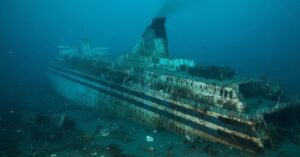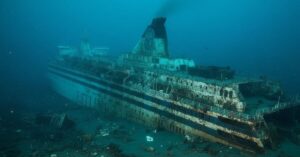
Video: 2 Dead, Over 20 Injured After Large Floating Crane Capsizes In Sevastopol
October 29, 2025
Cargo Ship Arrested At India’s Paradip Port Over ₹2.11 Crore Unpaid Dues
October 29, 2025

Russian intelligence agencies may have secretly used the wreck of the MS Estonia ferry in the Baltic Sea as a covert base for underwater surveillance targeting NATO operations, according to a joint investigation by German media outlets WDR, NDR, and Süddeutsche Zeitung published on October 24.
The joint investigation revealed that Russian operatives could have installed devices near the wreck capable of guiding underwater drones and submersible robots while collecting the acoustic “signatures” of NATO warships and submarines. These unique sound patterns, produced by engines and propellers, are critical in identifying vessels at sea.
The ferry wreck is protected under an international agreement between Sweden, Estonia, and Finland that prohibits diving in the area. Because of this restriction, the alleged Russian devices could have remained undetected for years.
Western intelligence agencies reportedly suspect that Russia’s Main Directorate of Deep-Sea Research (known as GUGI, a secretive branch of the Russian Defense Ministry, was behind the operation.
GUGI is known for its underwater espionage and sabotage missions. It operates several specialised vessels, including the Yantar, which NATO regards as one of Russia’s key spy ships. The Yantar has been tracked multiple times near critical undersea cables and infrastructure in the North and Baltic Seas.
The German outlets reported that Russian companies have, for years, obtained Western-made underwater surveillance technologies through intermediaries, particularly firms registered in Cyprus.
The estimated value of such purchases is around $50 million. The same technologies are said to be used in Russia’s “Harmony” project, an underwater sensor network in the Barents Sea designed to detect Western submarines and safeguard Russia’s Arctic fleet.
Several NATO countries, including Lithuania, Latvia, the United Kingdom, and Ireland, have reportedly discovered unidentified underwater sensors suspected to be Russian-made.
The MS Estonia sank on September 28, 1994, during a storm while sailing from Tallinn to Stockholm, resulting in the deaths of 852 people. It remains one of Europe’s worst peacetime maritime disasters. The wreck lies about 35 kilometers southeast of Finland’s Utö island, at a depth of roughly 80 meters.
In 1995, Sweden, Estonia, and Finland signed an agreement declaring the wreck a protected gravesite, banning dives to preserve the sanctity of the site. Although there were initial plans to encase the wreck in concrete, those were abandoned following objections from victims’ families and concerns that it could hinder future investigations.
Between 2021 and 2024, parts of the protection zone were temporarily lifted to allow for new probes into the sinking’s cause. During this period, NATO member states reportedly observed increased Russian underwater activity in the surrounding waters.
Authorities in Finland, Estonia, and Germany confirmed they are closely monitoring developments in the Baltic Sea. However, they have declined to disclose operational details, citing national security reasons.
An Estonian Foreign Ministry representative reportedly said that, along with allies, Estonia continues to closely monitor the Baltic region amid increasing Russian aggression since the invasion of Ukraine.
The Finnish Border Guard stated it would not release details of any surveillance operations but emphasised its awareness of Russian intelligence activities.
Reference: tagesschau
Source: Maritime Shipping News


